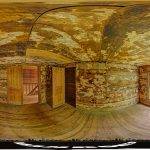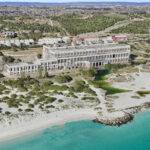Hiram Caldwell House
Check out this 360-degree panoramic virtual tour of the historical Hiram Caldwell House that is located in the Cataloochee area of the Great Smokey Mountains National Park in North Carolina. Be sure to click through all thirty-one (31) panoramic images. Do you like urban exploring? Here is a map with tons of GPS locations for you to get out and explore.
Click here to view it in fullscreen.
Exploring the Hiram Caldwell House
There’s a natural curiosity in many people, and urban exploring is one way for people to explore their curiosity about structures and old abandoned homes around the world. Exploring old homes where people once lived can make you feel as if you step through time. The Hiram Caldwell House in The Great Smoky Mountain National Park in Cataloochee Valley is one of many abandoned homes and historical sites that urban explorers love to visit.
History of the Caldwell House
The Caldwell house is one of the few remaining homes built in the once-thriving community of Cataloochee, located in the Cataloochee Valley in the Great Smoky Mountains. There were once almost 200 buildings, the largest community, spread out amongst the valleys.
Early in the 19th century, settlers used the land in the surrounding Cataloochee valley to raise their livestock. In 1834, Henry Colwell, later changed to Caldwell, purchased land and moved his family along with Young Bennett and his family. The two families settled there through generations, along with hundreds of other settlers, until the government designated the Great Smoky Mountains as a National Park. They were forced to move in the early 1930s and 1940s.
The Caldwell House was built by Hiram Caldwell and was completed in 1906. It overlooks Rough Fork Creek with picturesque views of the park all around. The two-story home has several rooms and two large porches on the front and back of the house.
While other structures remain in the settlement, the Hiram Caldwell House has more of a personal feel. The walls were decorated using old newspapers where you can still read glimpses of timelines once relevant and can provide insight as to what life was like over 100 years ago. The walls are adorned with notes and pictures of the Caldwell family that once lived there but remain free of furniture to deter thieves and prevent vandalism.
The Cataloochee Valley Settlers
The land was the perfect place to raise livestock and was one of the primary reasons settlers moved to the land. There was plenty of wild game where hunters collected furs to trade for other goods. Life in Cataloochee was difficult because of the wild animals such as bears and panthers that threatened their livestock and their safety. While the early settlers were on good terms with the Cherokees, there were some occasions when livestock would be stolen.
In the early 1900s, people began to explore the Great Smoky Mountains, and tourists were visiting the mineral-rich springs, believed to have healing powers. The residents of the Cataloochee valley often welcomed people staying, and hotels like the Cataloochee Ranch sprang up to accommodate tourists, and the community was thriving.
While tourism continuously increased, loggers started to cut down trees in the surrounding forests threatening the beautiful landscapes. The government decided to create the National Park to protect the land from destruction and preserve nature. The park boundaries encompassed the settlement of Cataloochee Valley, and homeowners were forced to sell. Although many people were given the ability to live on the lands on lifetime leases, people were eventually forced out by 1943.
Visiting the Hiram Caldwell House and the surrounding settlements as an Urban Explorer can give you a glimpse into the life of a settler of the early 1900s. The beautiful home can be visited during the national park hours and explored freely. The house is a beautiful structure that remains amidst the beautiful valley and is a sight to see.
Here is an 8K 360VR video of the location
Check out some other locations near by such as the Beech Grove School, Steve Woody House, Jarvis Palmer House or even the Palmer Chapel Methodist Church.
Do you have 360-degree panoramic images captured in an abandoned location? Send your images to Abandonedin360@gmail.com. If you choose to go out and do some urban exploring in your town, here are some safety tips before you head out on your Urbex adventure.
Equipment used to capture the 360-degree panoramic images:
- Canon DSLR camera
- Canon 8-15mm fisheye
- Manfrotto tripod
- Custom rotating tripod head
If you want to start shooting 360-degree panoramic images, you might want to look onto one-click 360-degree action cameras.
Click on a state below and explore the top abandoned places for urban exploring in that state.







6 Comments
[…] a little less busy than the other homes within the area, such as the Jarvis Palmer House or the Hiram Caldwell House, making it a more peaceful adventure. Visiting these homes gives you a unique glimpse into what […]
[…] abandoned in place and maintained by national park rangers and volunteers. You can also visit the Hiram Caldwell House, Steve Woody House, Jarvis Palmer House or the near by Palmer Chapel Methodist Church when you […]
[…] are a few other locations near the Jim Hannah Cabin that you might find interesting, the Hiram Caldwell House, the Jarvis Palmer House, or the Palmer Chapel Methodist […]
[…] time after 1950. Other locations in the area you might find interesting are, Jarvis Palmer House, Hiram Caldwell House, Jim Hannah Cabin or the Beech Grove […]
[…] Other nearby locations that you might find interesting include the Beech Grove School, Palmer Chapel Methodist Church, Steve Woody House or the Hiram Caldwell House. […]
[…] can also visit the Hiram Caldwell House, Steve Woody House, Beech Grove School or even the Jarvis Palmer House which are all […]